Hongwei Zheng
CodeBC: A More Secure Large Language Model for Smart Contract Code Generation in Blockchain
Apr 28, 2025Abstract:Large language models (LLMs) excel at generating code from natural language instructions, yet they often lack an understanding of security vulnerabilities. This limitation makes it difficult for LLMs to avoid security risks in generated code, particularly in high-security programming tasks such as smart contract development for blockchain. Researchers have attempted to enhance the vulnerability awareness of these models by training them to differentiate between vulnerable and fixed code snippets. However, this approach relies heavily on manually labeled vulnerability data, which is only available for popular languages like Python and C++. For low-resource languages like Solidity, used in smart contracts, large-scale annotated datasets are scarce and difficult to obtain. To address this challenge, we introduce CodeBC, a code generation model specifically designed for generating secure smart contracts in blockchain. CodeBC employs a three-stage fine-tuning approach based on CodeLlama, distinguishing itself from previous methods by not relying on pairwise vulnerability location annotations. Instead, it leverages vulnerability and security tags to teach the model the differences between vulnerable and secure code. During the inference phase, the model leverages security tags to generate secure and robust code. Experimental results demonstrate that CodeBC outperforms baseline models in terms of BLEU, CodeBLEU, and compilation pass rates, while significantly reducing vulnerability rates. These findings validate the effectiveness and cost-efficiency of our three-stage fine-tuning strategy, making CodeBC a promising solution for generating secure smart contract code.
Learning to Erase Private Knowledge from Multi-Documents for Retrieval-Augmented Large Language Models
Apr 14, 2025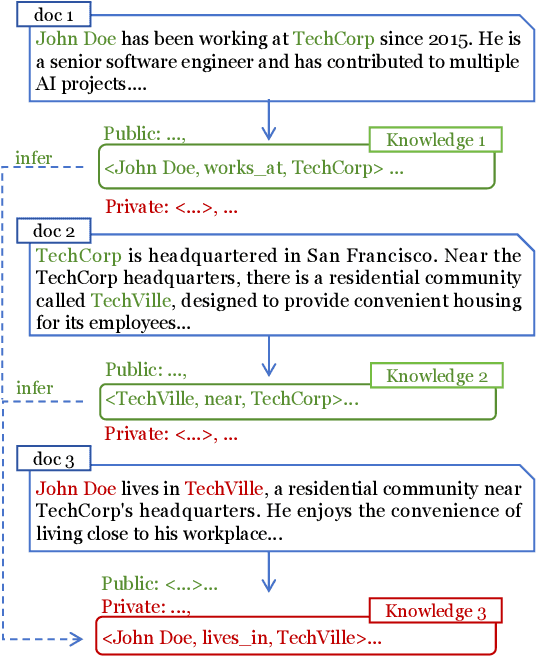



Abstract:Retrieval-Augmented Generation (RAG) is a promising technique for applying LLMs to proprietary domains. However, retrieved documents may contain sensitive knowledge, posing risks of privacy leakage in generative results. Thus, effectively erasing private information from retrieved documents is a key challenge for RAG. Unlike traditional text anonymization, RAG should consider: (1) the inherent multi-document reasoning may face de-anonymization attacks; (2) private knowledge varies by scenarios, so users should be allowed to customize which information to erase; (3) preserving sufficient publicly available knowledge for generation tasks. This paper introduces the privacy erasure task for RAG and proposes Eraser4RAG, a private knowledge eraser which effectively removes user-defined private knowledge from documents while preserving sufficient public knowledge for generation. Specifically, we first construct a global knowledge graph to identify potential knowledge across documents, aiming to defend against de-anonymization attacks. Then we randomly split it into private and public sub-graphs, and fine-tune Flan-T5 to rewrite the retrieved documents excluding private triples. Finally, PPO algorithm optimizes the rewriting model to minimize private triples and maximize public triples retention. Experiments on four QA datasets demonstrate that Eraser4RAG achieves superior erase performance than GPT-4o.
HiPART: Hierarchical Pose AutoRegressive Transformer for Occluded 3D Human Pose Estimation
Mar 30, 2025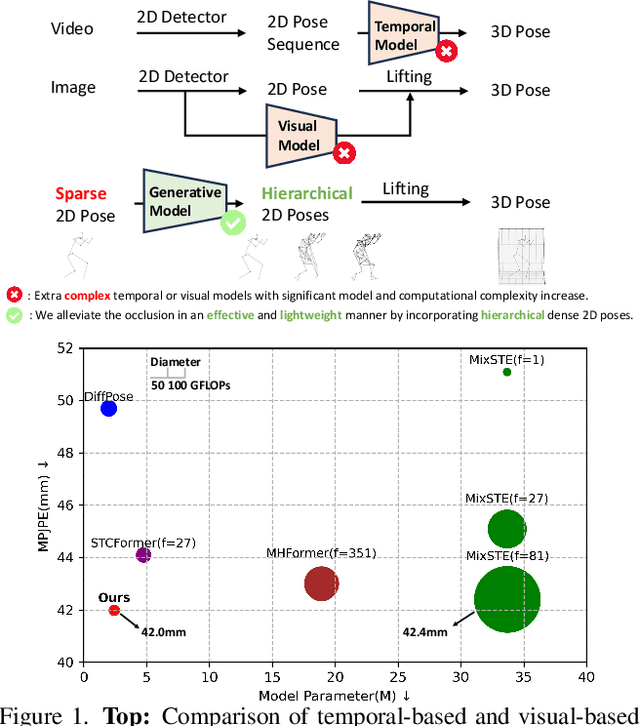
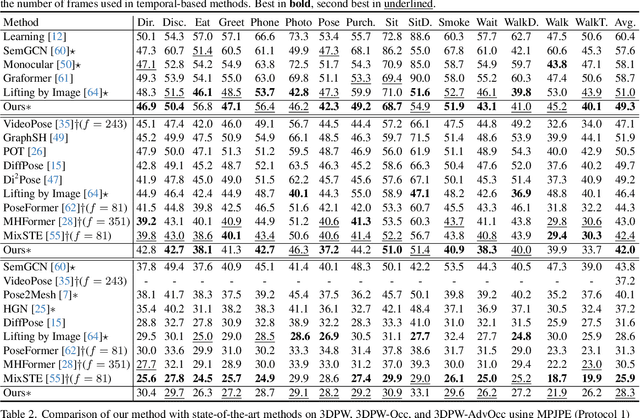
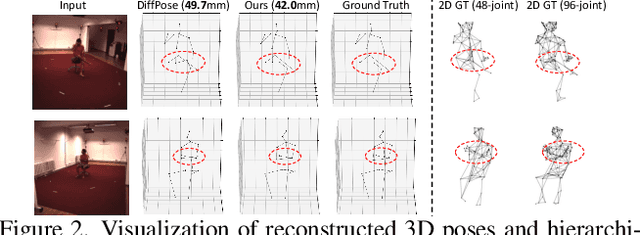
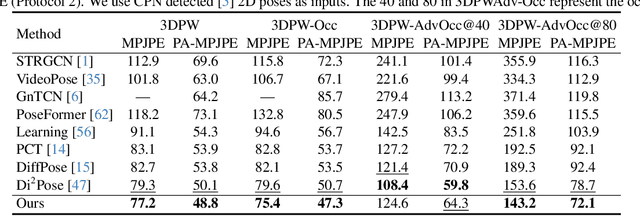
Abstract:Existing 2D-to-3D human pose estimation (HPE) methods struggle with the occlusion issue by enriching information like temporal and visual cues in the lifting stage. In this paper, we argue that these methods ignore the limitation of the sparse skeleton 2D input representation, which fundamentally restricts the 2D-to-3D lifting and worsens the occlusion issue. To address these, we propose a novel two-stage generative densification method, named Hierarchical Pose AutoRegressive Transformer (HiPART), to generate hierarchical 2D dense poses from the original sparse 2D pose. Specifically, we first develop a multi-scale skeleton tokenization module to quantize the highly dense 2D pose into hierarchical tokens and propose a Skeleton-aware Alignment to strengthen token connections. We then develop a Hierarchical AutoRegressive Modeling scheme for hierarchical 2D pose generation. With generated hierarchical poses as inputs for 2D-to-3D lifting, the proposed method shows strong robustness in occluded scenarios and achieves state-of-the-art performance on the single-frame-based 3D HPE. Moreover, it outperforms numerous multi-frame methods while reducing parameter and computational complexity and can also complement them to further enhance performance and robustness.
FineFilter: A Fine-grained Noise Filtering Mechanism for Retrieval-Augmented Large Language Models
Feb 18, 2025



Abstract:Retrieved documents containing noise will hinder Retrieval-Augmented Generation (RAG) from detecting answer clues, necessitating noise filtering mechanisms to enhance accuracy. Existing methods use re-ranking or summarization to identify the most relevant sentences, but directly and accurately locating answer clues from these large-scale and complex documents remains challenging. Unlike these document-level operations, we treat noise filtering as a sentence-level MinMax optimization problem: first identifying the potential clues from multiple documents using contextual information, then ranking them by relevance, and finally retaining the least clues through truncation. In this paper, we propose FineFilter, a novel fine-grained noise filtering mechanism for RAG consisting of a clue extractor, a re-ranker, and a truncator. We optimize each module to tackle complex reasoning challenges: (1) Clue extractor firstly uses sentences containing the answer and similar ones as fine-tuned targets, aiming at extracting sufficient potential clues; (2) Re-ranker is trained to prioritize effective clues based on the real feedback from generation module, with clues capable of generating correct answer as positive samples and others as negative; (3) Truncator takes the minimum clues needed to answer the question (truncation point) as fine-tuned targets, and performs truncation on the re-ranked clues to achieve fine-grained noise filtering. Experiments on three QA datasets demonstrate that FineFilter significantly outperforms baselines in terms of performance and inference cost. Further analysis on each module shows the effectiveness of our optimizations for complex reasoning.
AdaComp: Extractive Context Compression with Adaptive Predictor for Retrieval-Augmented Large Language Models
Sep 03, 2024



Abstract:Retrieved documents containing noise will hinder RAG from detecting answer clues and make the inference process slow and expensive. Therefore, context compression is necessary to enhance its accuracy and efficiency. Existing context compression methods use extractive or generative models to retain the most query-relevant sentences or apply the information bottleneck theory to preserve sufficient information. However, these methods may face issues such as over-compression or high computational costs. We observe that the retriever often ranks relevant documents at the top, but the exact number of documents needed to answer the query is uncertain due to the impact of query complexity and retrieval quality: complex queries like multi-hop questions may require retaining more documents than simpler queries, and a low-quality retrieval may need to rely on more documents to generate accurate outputs. Therefore, determining the minimum number of required documents (compression rate) is still a challenge for RAG. In this paper, we introduce AdaComp, a low-cost extractive context compression method that adaptively determines the compression rate based on both query complexity and retrieval quality. Specifically, we first annotate the minimum top-k documents necessary for the RAG system to answer the current query as the compression rate and then construct triplets of the query, retrieved documents, and its compression rate. Then, we use this triplet dataset to train a compression-rate predictor. Experiments on three QA datasets and one conversational Muiti-doc QA dataset show that AdaComp significantly reduces inference costs while maintaining performance nearly identical to uncompressed models, achieving a balance between efficiency and performance.
MaFeRw: Query Rewriting with Multi-Aspect Feedbacks for Retrieval-Augmented Large Language Models
Aug 30, 2024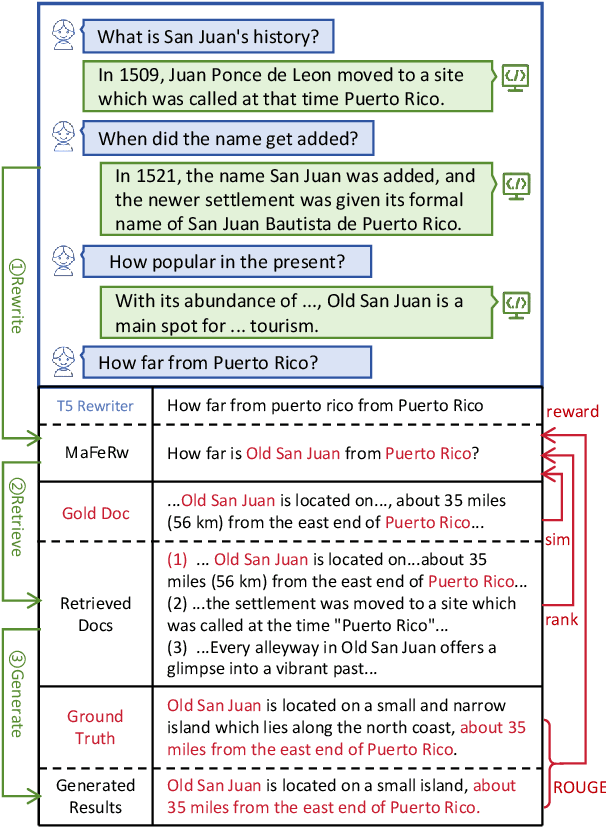

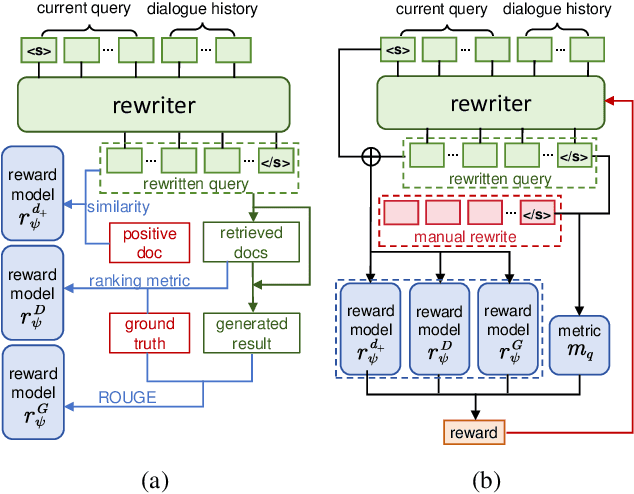

Abstract:In a real-world RAG system, the current query often involves spoken ellipses and ambiguous references from dialogue contexts, necessitating query rewriting to better describe user's information needs. However, traditional context-based rewriting has minimal enhancement on downstream generation tasks due to the lengthy process from query rewriting to response generation. Some researchers try to utilize reinforcement learning with generation feedback to assist the rewriter, but these sparse rewards provide little guidance in most cases, leading to unstable training and generation results. We find that user's needs are also reflected in the gold document, retrieved documents and ground truth. Therefore, by feeding back these multi-aspect dense rewards to query rewriting, more stable and satisfactory responses can be achieved. In this paper, we propose a novel query rewriting method MaFeRw, which improves RAG performance by integrating multi-aspect feedback from both the retrieval process and generated results. Specifically, we first use manual data to train a T5 model for the rewriter initialization. Next, we design three metrics as reinforcement learning feedback: the similarity between the rewritten query and the gold document, the ranking metrics, and ROUGE between the generation and the ground truth. Inspired by RLAIF, we train three kinds of reward models for the above metrics to achieve more efficient training. Finally, we combine the scores of these reward models as feedback, and use PPO algorithm to explore the optimal query rewriting strategy. Experimental results on two conversational RAG datasets demonstrate that MaFeRw achieves superior generation metrics and more stable training compared to baselines.
BEM: Balanced and Entropy-based Mix for Long-Tailed Semi-Supervised Learning
Apr 01, 2024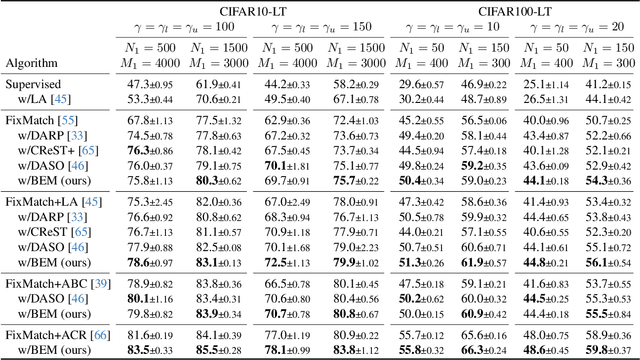
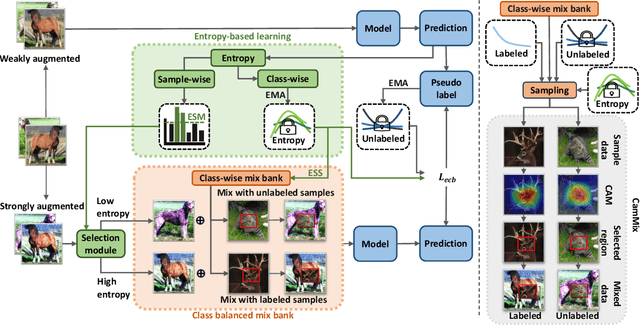

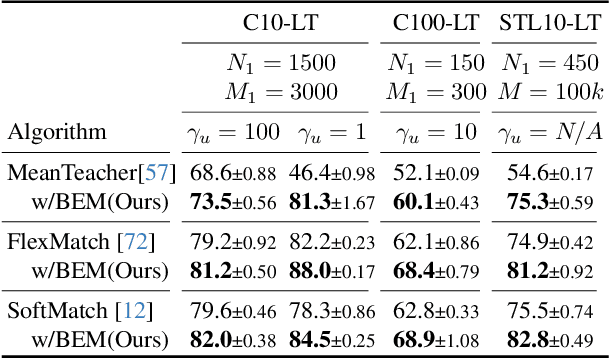
Abstract:Data mixing methods play a crucial role in semi-supervised learning (SSL), but their application is unexplored in long-tailed semi-supervised learning (LTSSL). The primary reason is that the in-batch mixing manner fails to address class imbalance. Furthermore, existing LTSSL methods mainly focus on re-balancing data quantity but ignore class-wise uncertainty, which is also vital for class balance. For instance, some classes with sufficient samples might still exhibit high uncertainty due to indistinguishable features. To this end, this paper introduces the Balanced and Entropy-based Mix (BEM), a pioneering mixing approach to re-balance the class distribution of both data quantity and uncertainty. Specifically, we first propose a class balanced mix bank to store data of each class for mixing. This bank samples data based on the estimated quantity distribution, thus re-balancing data quantity. Then, we present an entropy-based learning approach to re-balance class-wise uncertainty, including entropy-based sampling strategy, entropy-based selection module, and entropy-based class balanced loss. Our BEM first leverages data mixing for improving LTSSL, and it can also serve as a complement to the existing re-balancing methods. Experimental results show that BEM significantly enhances various LTSSL frameworks and achieves state-of-the-art performances across multiple benchmarks.
ActionPrompt: Action-Guided 3D Human Pose Estimation With Text and Pose Prompting
Jul 18, 2023
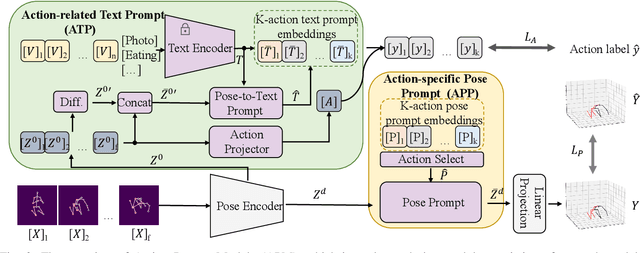
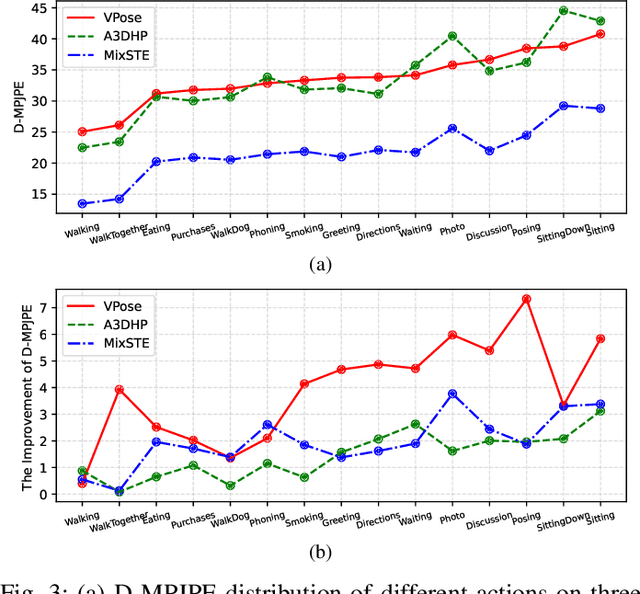

Abstract:Recent 2D-to-3D human pose estimation (HPE) utilizes temporal consistency across sequences to alleviate the depth ambiguity problem but ignore the action related prior knowledge hidden in the pose sequence. In this paper, we propose a plug-and-play module named Action Prompt Module (APM) that effectively mines different kinds of action clues for 3D HPE. The highlight is that, the mining scheme of APM can be widely adapted to different frameworks and bring consistent benefits. Specifically, we first present a novel Action-related Text Prompt module (ATP) that directly embeds action labels and transfers the rich language information in the label to the pose sequence. Besides, we further introduce Action-specific Pose Prompt module (APP) to mine the position-aware pose pattern of each action, and exploit the correlation between the mined patterns and input pose sequence for further pose refinement. Experiments show that APM can improve the performance of most video-based 2D-to-3D HPE frameworks by a large margin.
Pose-Oriented Transformer with Uncertainty-Guided Refinement for 2D-to-3D Human Pose Estimation
Feb 15, 2023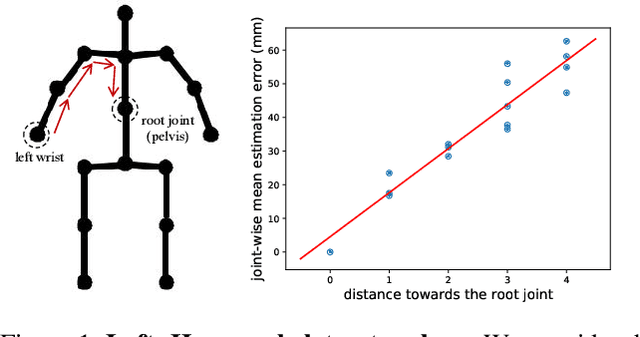



Abstract:There has been a recent surge of interest in introducing transformers to 3D human pose estimation (HPE) due to their powerful capabilities in modeling long-term dependencies. However, existing transformer-based methods treat body joints as equally important inputs and ignore the prior knowledge of human skeleton topology in the self-attention mechanism. To tackle this issue, in this paper, we propose a Pose-Oriented Transformer (POT) with uncertainty guided refinement for 3D HPE. Specifically, we first develop novel pose-oriented self-attention mechanism and distance-related position embedding for POT to explicitly exploit the human skeleton topology. The pose-oriented self-attention mechanism explicitly models the topological interactions between body joints, whereas the distance-related position embedding encodes the distance of joints to the root joint to distinguish groups of joints with different difficulties in regression. Furthermore, we present an Uncertainty-Guided Refinement Network (UGRN) to refine pose predictions from POT, especially for the difficult joints, by considering the estimated uncertainty of each joint with uncertainty-guided sampling strategy and self-attention mechanism. Extensive experiments demonstrate that our method significantly outperforms the state-of-the-art methods with reduced model parameters on 3D HPE benchmarks such as Human3.6M and MPI-INF-3DHP
Cross-Camera Feature Prediction for Intra-Camera Supervised Person Re-identification across Distant Scenes
Jul 29, 2021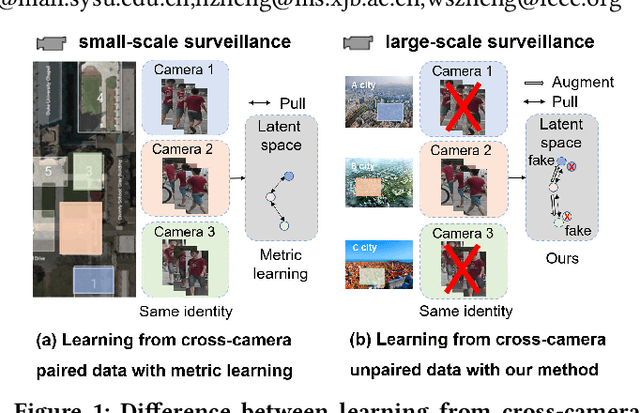
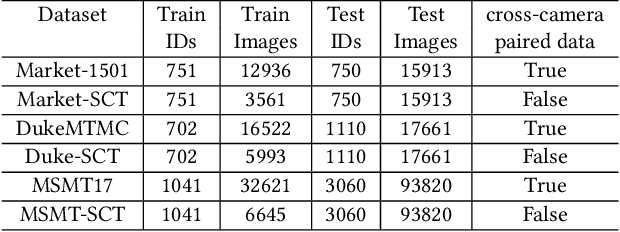
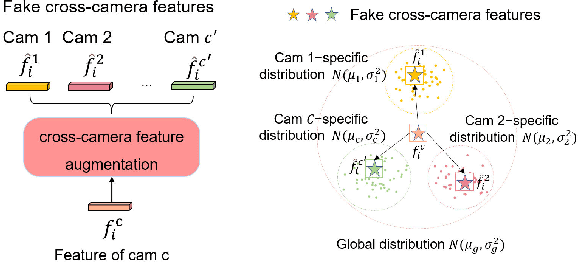
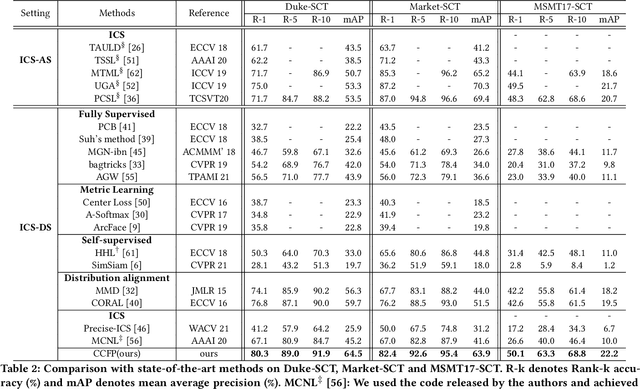
Abstract:Person re-identification (Re-ID) aims to match person images across non-overlapping camera views. The majority of Re-ID methods focus on small-scale surveillance systems in which each pedestrian is captured in different camera views of adjacent scenes. However, in large-scale surveillance systems that cover larger areas, it is required to track a pedestrian of interest across distant scenes (e.g., a criminal suspect escapes from one city to another). Since most pedestrians appear in limited local areas, it is difficult to collect training data with cross-camera pairs of the same person. In this work, we study intra-camera supervised person re-identification across distant scenes (ICS-DS Re-ID), which uses cross-camera unpaired data with intra-camera identity labels for training. It is challenging as cross-camera paired data plays a crucial role for learning camera-invariant features in most existing Re-ID methods. To learn camera-invariant representation from cross-camera unpaired training data, we propose a cross-camera feature prediction method to mine cross-camera self supervision information from camera-specific feature distribution by transforming fake cross-camera positive feature pairs and minimize the distances of the fake pairs. Furthermore, we automatically localize and extract local-level feature by a transformer. Joint learning of global-level and local-level features forms a global-local cross-camera feature prediction scheme for mining fine-grained cross-camera self supervision information. Finally, cross-camera self supervision and intra-camera supervision are aggregated in a framework. The experiments are conducted in the ICS-DS setting on Market-SCT, Duke-SCT and MSMT17-SCT datasets. The evaluation results demonstrate the superiority of our method, which gains significant improvements of 15.4 Rank-1 and 22.3 mAP on Market-SCT as compared to the second best method.
 Add to Chrome
Add to Chrome Add to Firefox
Add to Firefox Add to Edge
Add to Edge